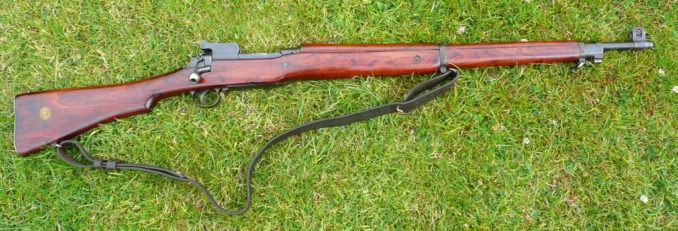

Introduction
The humiliations suffered by the British Army at the hands of untrained Boer irregulars during the Anglo-Boer War of 1899-1902 caused a great deal of concern at the War Office where questions were soon being asked about the adequacy of the then standard issue .303 Magazine Lee-Enfield infantry rifles and carbines. The thinking was that, as the British soldier was unquestionably the best in the world, any defeats inflicted must therefore have been due to the use of superior weaponry by the enemy that gave them an unfair advantage – and to an extent this was true.
The .303 Magazine Lee-Metford rifle was introduced in 1888 originally for use with a cartridge utilising a 70 grain compressed charge of black powder but its shallow Metford rifling that had proved so effective in muzzle-loading black powder target rifles was rapidly eroded when the much hotter burning, smokeless Cordite round that superseded it from 1891 onwards appeared. To overcome this problem, new deeper rifling developed at the Royal Ordnance Factory, Enfield was adopted and thus the Lee-Enfield rifle was born.
However, these early Lee-Enfields soon developed a reputation for poor accuracy as, due to a sighting defect and an incompetent government acceptance standard based on tightness of group rather than shot placement on the target, they shot 18 inches to the right of the aiming point at 500 yards. As neither the front nor rear sights on these rifles could be adjusted for ‘windage’ (side-to-side movement) in the field, batches of rifles had to be shipped back to England from South Africa for adjustment and new rear sight leaves with the V offset 0.03 inch to the left were introduced as a temporary solution.
Another problem was that the British rifle, unlike the Boer’s favourite, the Model 1893/95 Mauser, had no provision for charger loading so despite having twice the magazine capacity, (ten rounds as opposed to five), it was significantly slower to load and fire. As if all this wasn’t enough, the rimmed British .303 Mk 1 Cordite cartridge (215 grain round-nose bullet – 1970 fps muzzle velocity) proved markedly inferior to the rimless Mauser 7x57mm (175 grain Spitzer (pointed) bullet – 2,300fps MV) that had allowed the Boers to pick off our troops with impunity from reported distances of anything up to 2,000 yards.
The Pattern 1913 Trials Rifle
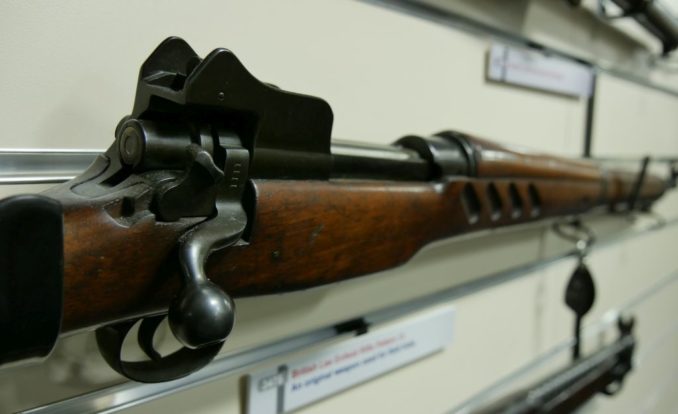
In 1904 the charger-loading Short, Magazine Lee-Enfield (SMLE), affectionately known as the ‘Smelly,’ replaced both the ‘Long Lee’ and its carbine derivatives but it was not until 1912 that an Enfield-designed prototype Mauser-type rifle was ready for use with a newly developed .276 magnum cartridge that drove a 165 grain bullet at 2785fps MV. The new Pattern 13 rifle had a one-piece stock for ease of manufacture, a Mauser-type action for strength, a five-round internal magazine without a cut-off lever and an aperture rear sight for improved accuracy.

The new cartridge would, if fully-developed, have had significant advantages over the .303 round then in use. With a higher velocity and hence flatter trajectory, it would have been more accurate with greater penetrating power and the absence of a rim on the case would have made loading easier with less tendency to jam. The performance of the .276 round was very similar to that of the modern 7mm Remington Magnum and as such it was very much ahead of its time.
However, in trials the new magnum ammunition was found to produce excessive muzzle-flash and recoil and due to the high burning temperature of the Cordite propellant it rapidly eroded the rifle barrels. Alarmingly, the rounds also had a habit of ‘cooking off’ or exploding prematurely due to the heat of the barrel once the round was chambered but before the trigger was pulled. Unfortunately, before these issues could be rectified, war broke out in August 1914 and all development work on the new cartridge was immediately stopped. Introducing a new calibre weapon in a time of war would have been a logistical nightmare.
Had more modern, cooler burning nitro-cellulose propellants been available at the time, this cartridge and the new rifle expressly designed to fire it would without doubt have been world-beaters.
The Pattern 1914 Rifle
By 1915 Britain had insufficient manufacturing capacity to satisfy its demand for rifles so the new rifle was rechambered to take the existing .303 cartridge and re-designated the Pattern 1914 or P14 rifle.
Vickers Ltd was initially awarded the contract to manufacture the new rifle but being fully-committed to machine-gun production was unable to produce more than a handful before alternative suppliers had to be found. As all suitable British firms were already running at full capacity on essential war work, the US firms of Winchester and Remington were contracted to produce them. To increase their production capacity, Remington bought and re-equipped a disused railway locomotive works at Eddystone, Pennsylvania especially for the manufacture of P14s. Production began in the USA in January 1916 and by April 1917 1.2 million rifles had been supplied.
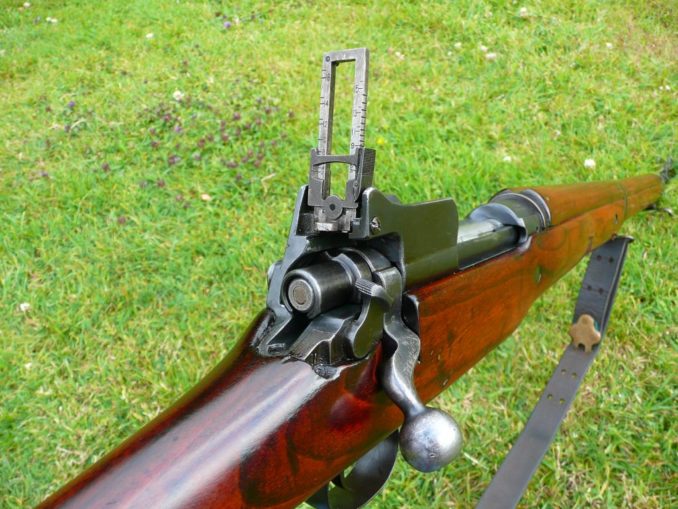
Unfortunately, quality control at the three factories was not coordinated and as a result it was found that some replacement parts would only fit rifles manufactured in the same factory. As interchangeability of parts in the field, pioneered during the American Civil War with the .58 Springfield rifle-musket, is an essential requirement for a battle rifle, the P14 with its Bisley target rifle refinements ended up mainly being used for training and rear echelon work.
Due to its inherent accuracy, the P14 did, however, find a niche as a sniper rifle and a few selected rifles (of Winchester manufacture only) were fitted with more finely adjustable aperture or telescopic sights. A few of these now very rare and consequently very collectable rifles were used by snipers in the final months of the Great War.
When the United States entered the war in 1917 and her own need for rifles was desperate, it seemed logical to adapt the existing machinery at the three factories to produce rifles chambered for the US 30-06 cartridge and hence the US Model 1917 rifle came into being. More M17s were used by US troops in WWI than Springfield 1903s, indeed Sergeant Alvin York won his Congressional Medal of Honour with an M17 and not a Springfield 03 as was carried by Gary Cooper in the 1941 film ‘Sergeant York’.
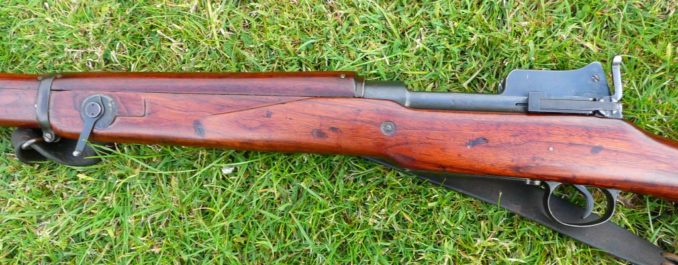
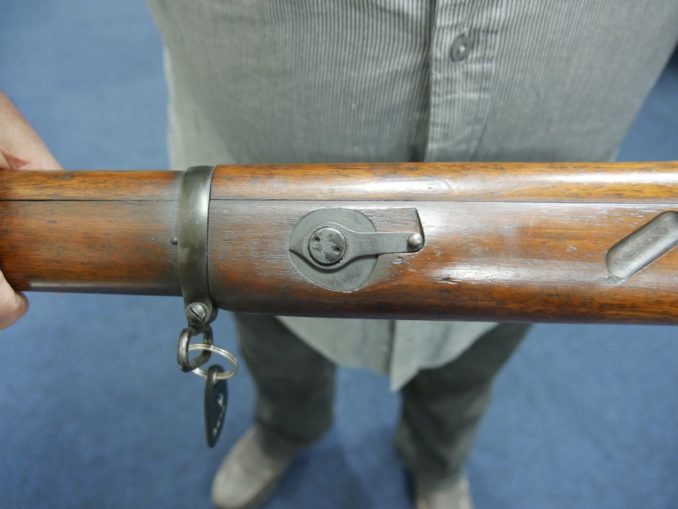
After the armistice in 1918 all existing stocks of P14s were put into storage. In 1936 the P14 was re-designated ‘Rifle No3 Mk1*’ and prior to and during WWII the rifles were refurbished to ‘Weedon Repair Standard’ having their original volley sights removed. These rifles were designated ‘Rifle No3 MkII (W) (R) or (E)’ depending on whether they were of Winchester, Remington or Eddystone manufacture. How my 1916 Eddystone P14 (pictured) managed to retain its volley sights is a mystery for which I am extremely thankful.
These rifles saw very little front line service during WWII being mainly issued for Home Guard use, RAF airfield security and for supply to partisan groups. Some US M17 rifles were supplied for similar duties and the butts of these were painted with a broad red stripe marked ‘30-06’ to differentiate them from the .303 P14s which were otherwise identical in appearance.
The main shortcomings of the P14 were that at 8lb 10oz unloaded it was heavier than the SMLE (8lb 3oz) and although more accurate at long range, with only a five-round magazine, they could not maintain an equivalent rate of fire. Rapid, accurate fire at 300 yards was highly valued by the Army where the ‘Mad Minute’ practice required 15 aimed shots to be fired prone in 60 seconds.
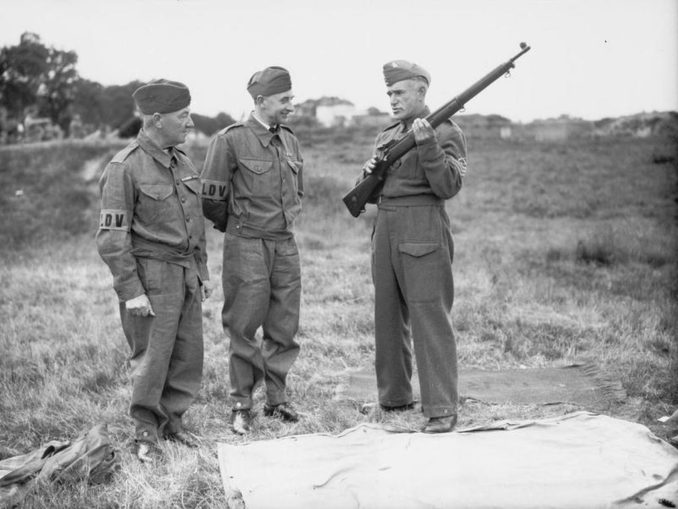

Bayonets
The correct bayonet for the P14 is the Pattern 1913 which, apart from the diameter of the fixing hole that goes over the muzzle, is identical to the Pattern 1907 bayonet that fits the SMLE. To avoid confusion, all bayonets for the P14 have a couple of deep grooves carved around their handles. I was very fortunate in being able to swap a US M1917 bayonet with the owner of an M17 rifle who just happened to have a British Pattern 1913. We were both happy with the outcome but I feel I got the better of the deal as the Pattern 13 bayonet is now quite difficult to come by.
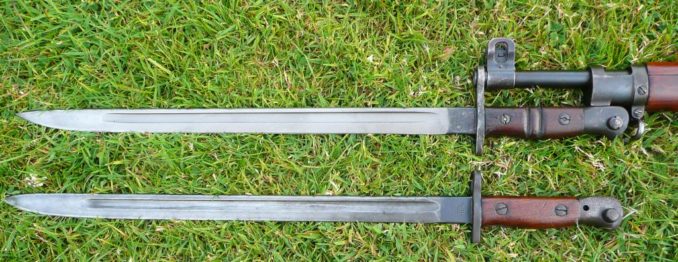
Conclusions
Had the outbreak of the Great War been delayed by only a couple of years, the technical difficulties experienced with the .276 magnum cartridge would have been overcome and the P13 rifle would have become the standard issue infantry weapon throughout the British Empire. It was a rifle ahead of its time, simple to manufacture, incredibly strong and very accurate with sophisticated yet robust sights with a much longer sight-radius than those on the SMLE that it was intended to replace.
Nevertheless, the .303 P14 is a superbly accurate and well-made rifle. It is a delight to shoot and while I make no claims to being a good shot, it was with my P14 that I had my most successful shoot some years ago when I came fourth in a 600 yard Enfield rifle only competition. ‘What’s so special about that?’ I hear you ask, well, while the other competitors were all using post-WWII rifles fitted with target front and rear sights and shooting the 7.62NATO cartridge, I was using my 1916 303 rifle as issued yet still finished only two points behind the third-placed man.
But don’t take my word for it, here’s what US Major-General Julian S Hatcher an acknowledged expert on firearms had to say on the subject in ‘Hatcher’s Notebooks’:
“The rifle that was being produced for the British was of highly advanced design, making it the best military rifle used during World War I. Though it was basically a typical Mauser, it was improved in several respects, and had a bolt and receiver of high grade nickel steel that gave it a superbly strong action. The well protected peep sight, mounted on the receiver, close to the shooter’s eye, with a front sight likewise protected by strong steel ears, gave a sighting combination that was far superior to that on the Springfield, and by a considerable margin the best and most practical of any seen in that war.”
So, even when converted to take the old-fashioned .303 British ammunition, the P14 was still a superb weapon. Sadly however, due to incompetent manufacturing practices in the American factories where the advice of British inspectors sent out specifically to improve quality control was often ignored (particularly by Winchester), rifles were produced many of whose parts were not interchangeable thus making them unsuitable for battlefield deployment. This necessitated marking supposedly identical rifles so as to indicate in which of the three factories they had been made.
During WWII these advanced yet undervalued rifles played an ignominious role on the home front only seeing real action in the hands of partisans in such far-flung places as Latvia, Lithuania, Estonia and Poland where they were very much appreciated.

The P14 was declared obsolete in British service in 1947 with surplus rifles being sold out of service throughout the Commonwealth where they proved popular as target rifles and, in sporterised form, as hunting rifles.
So the next time ‘Dad’s Army’ is on TV, amaze your family and gain valuable anorak points by casually pointing out to all present that the members of Captain Mainwaring’s Home Guard platoon are each carrying period-correct P14 rifles and not SMLEs as most people assume. If you have a tin hat handy, it might be a good idea to put it on before sharing your expertise. Nobody likes a smartarse.
Note: This amended article was first published in July 2019 but was removed shortly afterwards as part of the Great GP Copyright Purge of that year.



